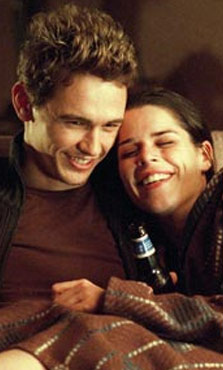 “The Company” is Robert Altman’s entertaining look at Chicago’s Joffrey Ballet, an original venture into the world of ballet dancing that manages to avoid the usual tale of the hard-working underdog who—by golly!—finally wins a chance to shake her stuff. The film looks and feels like Altman was given the studio’s most commercial cut, absconded with it to the secrecy of the editing room, and then sent an opposite version to theaters. It’s as if he had gone to shoot a Hollywood feel-good weepie and discovered something infinitely more engaging, for in the end the subject is exactly what it purports to be, the company of dancers, and not the struggles of any of its members, no matter how FOXy the resume of its cast. “The Company” is Robert Altman’s entertaining look at Chicago’s Joffrey Ballet, an original venture into the world of ballet dancing that manages to avoid the usual tale of the hard-working underdog who—by golly!—finally wins a chance to shake her stuff. The film looks and feels like Altman was given the studio’s most commercial cut, absconded with it to the secrecy of the editing room, and then sent an opposite version to theaters. It’s as if he had gone to shoot a Hollywood feel-good weepie and discovered something infinitely more engaging, for in the end the subject is exactly what it purports to be, the company of dancers, and not the struggles of any of its members, no matter how FOXy the resume of its cast.
Indeed, Neve Campbell (who co-produced and co-wrote the story) seems to have been especially honorable in signing off on what is, at heart, an avant-garde film. Altman throws the audience into the midst of a multifaceted production and allows it to discover what it’s all about, move by move, routine by routine. The camera actually opens in the middle of the audience, with a row of heads lining the bottom of the screen, and takes us from the outside into the inner workings of this disciplined and intricately collective endeavor. This is effective, all the more so because most of us are used to more structured affairs which provide the comforting footholds of schmaltzy dance movie melodrama (such as the guilty pleasure “Center Stage”). The result is the keenest and most watchable look at the whole spectrum of a company of stage performers since Mike Leigh’s “Topsy-Turvy”.
With Campbell and James Franco on the marquee, the Cute Squint factor was dangerously high. Add to the mix a hilariously hammy Malcom McDowell as the mercurial director and the recipe was ready for all the usual fireworks. Altman evades them with a low-key approach that carefully smooths away any dramatic ripples that threaten to disrupt his taut, documentary-style reportage of the dancers. Particularly wonderful is an extended scene in which a storm threatens to ruin a fine outdoor performance by Campbell and her partner. As the wind picks up and the rain begins, it looks like the weather will ruin the show. Yet the dancers are so entrancing that we are not at all surprised to see a casual bloom of umbrellas rather than a scrum of fleeing patrons.
The coordination of the dancers is a type of synergy between mind and body that Altman also finds in other places, such as in Franco’s skills as a chef. Franco doesn’t have much screen time, but when he does, he’s often sharing time with spatulas and sauce pans. Altman’s camera lingers over his hands as they work with these tools, and in this way “The Company” can also be seen as an appreciation of artistic craft. Campbell (who is convincing as a dancer) and Franco certainly have the attractive chemistry of the twenty-something tabloid bait they are, but their affair is never allowed the foreground for more than a few minutes at a time. Altman pulls away at every turn. Their initial meeting is captured in gestures, their first fight done in scene blocking (a miracle of economy considering how this would have been handled in a traditional screenplay). Only the dance sequences are given our full attention in order to underscore the basic truth of the Joffrey. The company is always greater than the sum of its interchangeable parts.
Altman’s discipline is almost equal to that of the dancers themselves, who dazzle us not only with their grace but their single-minded determination and astonishing muscular exertion. They’re tough, too. When one of the dancers snaps her Achilles tendon, her reaction is as restrained as if she’d stepped on a small thorn. The body of a pro basketball player, suffering the same injury, would assume all manner of terrifying contortions; that the dancer’s does not is probably an example of extremely bad acting but may be an indication of the toughness of these physical marvels. One of Altman’s achievements is that we come to believe it’s the latter. |